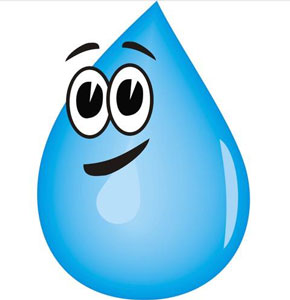
By Jean Ponzi
Prompted by a kitchen update, this a First-World problem to have, and – full disclosure – my household flow stayed on for one toilet, tub and the bathroom sink.
My plumber (aka Husband Dale) checked and re-checked diagrams, pipe and elbow inventory, and much more. His planning layout had the meticulous clarity of mosaics adorning a Turkish Bath. As with any project, preparation was key.
Early on Plumbing Day, when Dale’s reno-buddy Bill arrived, one Main Shutoff quarter-turn voluntarily marooned us where many living beings are forced to go. I used the time to refill my reservoir of water lore.
Remembering that our brains are 75% water, I understand brain drain in a whole new way.
We need The Facilities, but flushing toilets recently used more water each day than all other common water uses combined. The U.S. Energy Policy Act of 1992 siphoned this consumption, mandating toilet redesign to cut the prior 3.5 gallons per flush to a mere 1.6 gpf.
Japanese hydrodynamic engineers had already whizzed past this new standard, but until their Toto company products caught on, our porcelain fixture industry suffered through the urge to Flush Twice. Today, domestic manufacturing is back on the throne: 1.28 gpf is the new unofficial standard for gravity-fed toilets, with some high-performing models using as little as 0.8 gpf. Amazing what a little regulation can do!
You don’t need many reasons not to drink toilet water, just Number One and Number Two.
While “constrained” to use of only one loo, I recalled our many trips to Loew’s when Dale was renovating our main bathroom, back in 2007. They had a model on display that could flush 32 golf balls. I tested that demo every time we passed through the toilet aisle, gleefully free of enviro-regret, since it used a recirculating tank. If it hadn’t been mounted out of my reach, I’m sure I would have written my name on some balls, so as to personally feel the thrill of water efficiency.
Subject to the Law of Gravity, water is on Most Wanted lists in three states: Solid, Liquid and Gas.
Our adult human bodies are 65% water, and water accounts for 80% of an infant’s body weight at birth. We require water to distribute nutrients to all our cells, lubricate joints, facilitate digestion, regulate temperature, and slosh out the soup of toxins modern life has us swimming in.
Turns out the ole’ maxim “8 Glasses a Day”(@ .24 liter per glass, or 1.9 liters) is a myth. To maintain our bods in tune, women are advised to drink 2.7 liters (a splash more than 11 glasses) and men should chug a whopping 3.7 liters, at least 15 full mugs.
When you are feeling blue, drink a gallon of water before you go to sleep. You’ll want to get up in the morning!
Fruit juice, milk, coffee, soda, and tea are “considered fluids” so they count toward hydration. But choosing Water vs water-y will keep the kidneys happiest, avoid empty calories – and circulate most cleanly through our individual hydrospheres.
All you need to know about celery is that it’s 95% water, and 100% not pizza.
There is zip, none, absolutely ZERO special oversight for testing or purifying bottled water. Bottled water comes from taps. The idea came from – wait for it – Coke and Pepsi, in one of the eras when their perpetually competing soda sales went flat. Coke hesitated, not wanting to dilute conventional drink profits, but – bravely tapping the examples of France’s carbonated Perrier and Maine-based bottler Poland Spring – Pepsi took the plunge with its Aquafina brand. “We’re a total beverage company,” Craig E. Weatherup, President and CEO of Pepsi-Cola North America, effused to the Associated Press in 1994. “When you reach for a beverage, we’ll be there.”
I considered launching a new bottled water brand, but the market was saturated.
A 1,000-square foot lawn can annually absorb 35,000 gallons of H20, and people tend to over-irrigate their lawns. Like watering in sunny mid-day when evaporation’s highest or letting auto-sprinklers run even in the rain. Over-irrigating can guzzle up to 75,000 gallons per year. Pricing for U.S. water and sewer service (utilities that are typically tied) continues to rise as infrastructure ages.
Just opened my water and electric bills at the same time. I was shocked.
Turfgrass is the single largest irrigated vegetation in the U.S., covering over 40 million acres, including about 68% of the total land around private residences. Native plants, by comparison, can reduce outdoor water use by 20-50%, depending on your landscape scheme while they restore and sustain biodiverse food webs, clean and manage stormwater, support pollinators, and sequester carbon. Plus our native plants will thrive on the free stuff, rain.
Owl couples turn nonchalant during monsoons because they are too wet to woo.
At the end of an epic 11.5-hour shift, my home’s intrepid plumber duo (lifetime friends Dale and Bill, combined age: 143 years) slathered hands with Goop and called it quits. Two days later, after a necessary in-house rest and only one round of me washing dishes in the bathtub, Dale’s final feed-line connections resumed our wondrously abundant water flow.
So cool how a faucet functions: its mechanism works in sink!
Green Jean Ponzi is awash in eco-logical fun, on her job with the EarthWays Center of Missouri Botanical Garden and through her Earthworms podcast interviews for KDHX.


